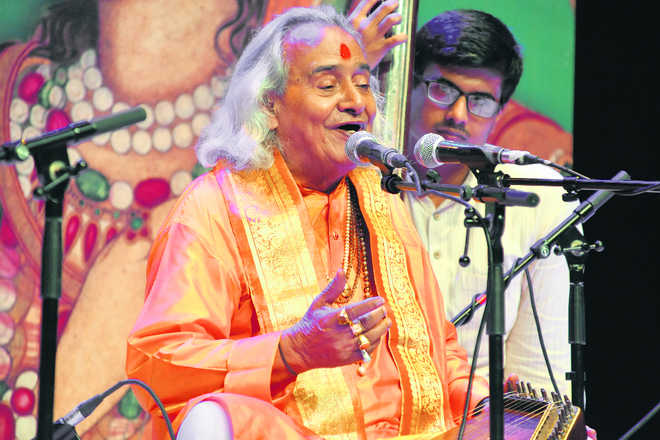
Swati Rai
The melodic blend of Hindustani semi-classical music with traits of folk literature, thumri is among the most eloquent traditions of Indian music. It originated in Benaras, Gwalior and Awadh and was patronised by royal kingdoms and palaces. Derived from the Hindi verb thumakna, no surprises then that this form is connected with dance, dramatic gestures, love poetry and folk songs.
Among the artists of the purab ang thumri of Benaras gharana, Pandit Chhannulal Mishra stands tall. Hailing from Benaras, he is a noted exponent of Kirana gharana, especially khayal gayaki and purab ang thumri. While we all like to fret over the fading Hindustani tradition, Mishra sees a heartening influx of many a new talent who are keen on being the future of Indian music. One saw exactly this at the recently concluded three-day thumri festival in the Capital.
An annual affair for over 12 years, this celebration of the form is supported by Sahitya Kala Parishad, Department of Art, Culture and Languages, Government of Delhi. It is designed to showcase veteran thumri singers and the new crop of outstanding young vocalists share space and light up the evening with their renditions.
On the sidelines of the festival, Pt Mishra shared his thoughts on the art form and its future. “Thumri has an element of chhand, loch and khayal, an amalgamation of soul and melodious tunes and beautiful explanation of the feelings and emotions that you represent through your singing.”
Question the stalwart on the changes he sees in the Indian classical music space, over the years, especially in thumri, and he says, “Those who have deep understanding of the music, interpret the meaning of thumri and relate it with its culture and tradition.” Still, for Mishra, it is the artist who conveys precise meaning, nuances and lyrical solidity.
He believes that it is the artist who has to explain the “emotion and backdrop” of the music. Else, the audience would seem disinterested and will move to other forms, he warns. “People nowadays want to listen to fast track music,” he adds. This is what he feels mandates an initiation of youngsters in the musical tradition and legacy.
Talking about the steps that the government is taking in this direction, the maestro comments, “According to me, lessons in thumri should be included in school books to give music disciples an in-depth knowledge of the Indian classical vocal form. Take it to schools and supplement it with opportunities to practice constantly.”
Pt. Mishra laments the fact that an artist is these days judged by her/his qualification and certification. “Until and unless one sees and listens to one’s composition, one cannot be certified as an established artist or benefactor of the art, culture and music industry.” Riyaaz, constant riyaaz, is the essence of this musical world, he says, and believes: “It is not a written composition that you just sing. One needs to add his soul and make it more spiritual and life-like.”
Once a song of courtesans
One of the most important forms of North Indian music after khayal, thumri is believed to have evolved at Nawab Wajid Ali Shah’s court in Lucknow. At that time, it was a song sung by courtesans. It is said that a new form of thumri took shape in the 19th century. This was independent of dance and the pace was much slower. This form was called bol-banav and evolved in Varanasi. Lyrics of a thumri, usually in Awadhi and Brij Bhasha, are romantic and devotional. Its themes largely revolve around Radha-Krishna scenes of love and separation. Lighter forms such as dadra, hori, kajari, saavan, jhoola and chaiti also use thumri as a generic umbrella term to describe them. Therefore, the exposition of these forms varies. Folk literature and music, as in other art forms, have a big hand in its origin and growth. Today, thumri is sometimes sung at the end of khayal concerts as a concluding item.
Add to playlist
- “Kahe chhed chhed mohe” by Madhuri Dixit/Birju Maharaj/Kavita Krishnamurthy — Devdas
- “Chhodo na mori baiyyaan” by Richa Sharma — Zubeida
- “Hamari atariya” by Rekha Bhardwaj — Dedh Ishqiya
- “Kaun gali gayo shyam” by Parveen Sultana — Pakeezah
- “Mohe pangat pe” by Lata Mangeshkar — Mughal-e-Azam
- “Bhar bhar aayi akhiyan” — Begum Akhtar, Jalsa Ghar
- “Kanha main tose hari” by Birju Maharaj, Shatranj ke Khiladi
- “Prem jogan ban ke” by Ustad Bade Ghulam Ali Khan —Mughal-e-Azam



























